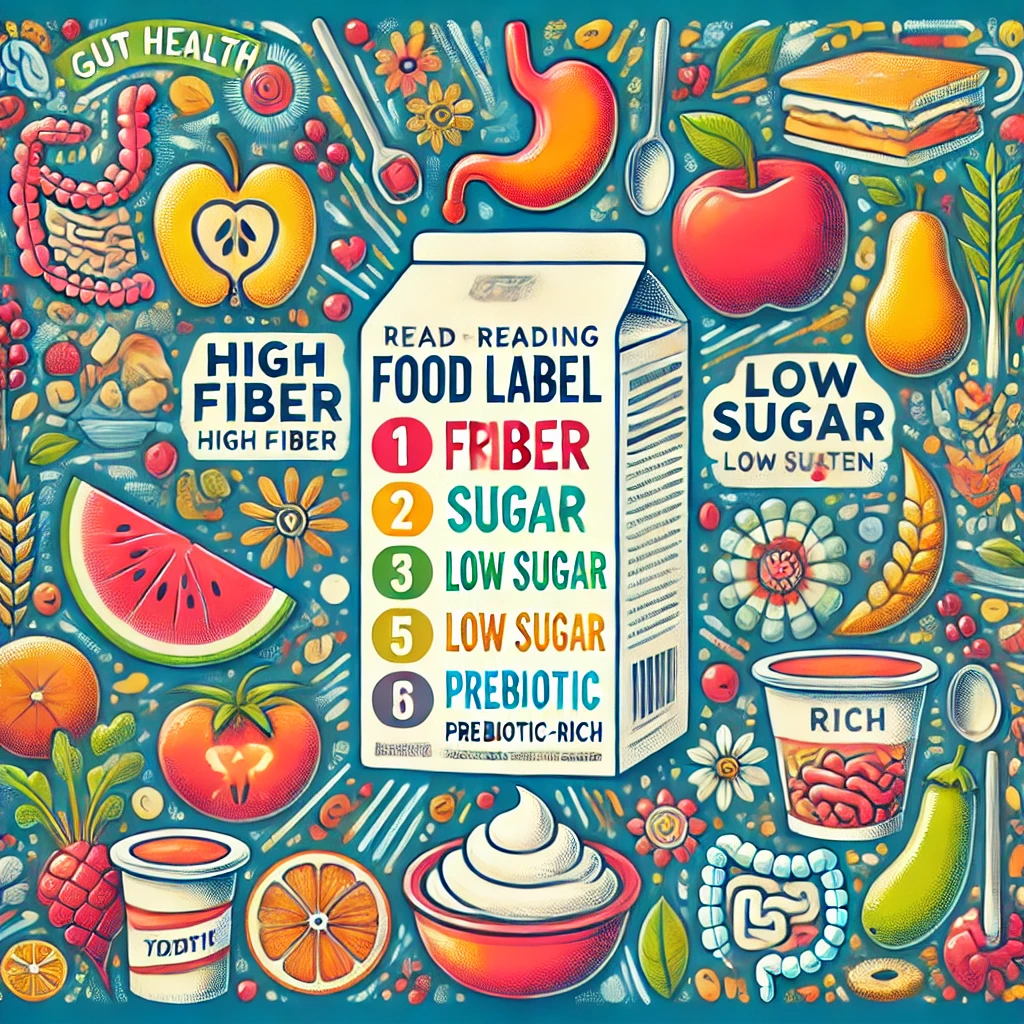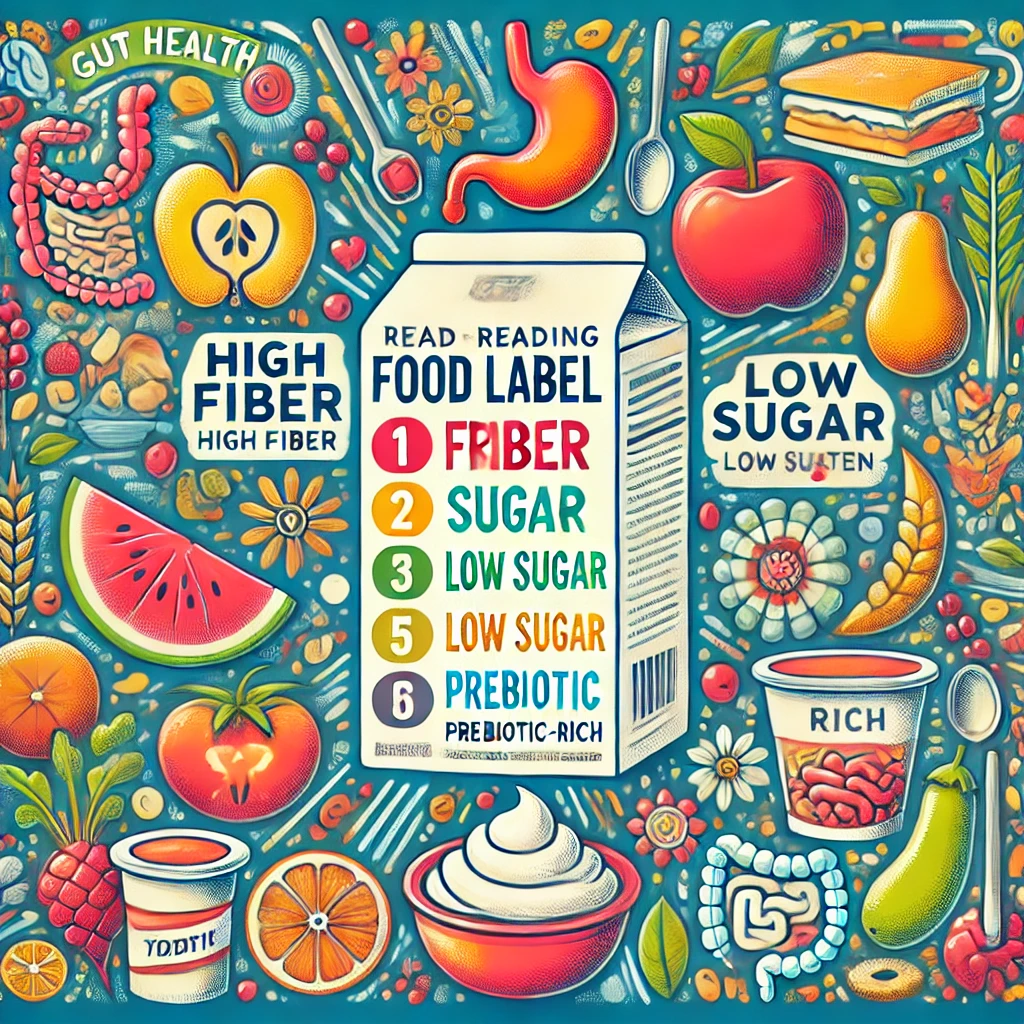
Gut health is more than just avoiding stomach issues—it’s the foundation of overall wellness, influencing digestion, immunity, and mental health. Your gut microbiome, a bustling community of trillions of bacteria, thrives on a balanced diet. Learning to read food labels empowers you to make choices that support a healthy microbiome and improve your overall well-being.
Reading food labels might seem mundane, but it’s one of the most powerful tools for making informed choices about what you eat. These small panels hold the key to understanding precisely what you’re putting into your body and how it impacts your gut health.
Food labels are indispensable for supporting a balanced and thriving gut microbiome. They reveal critical details about
- Fiber content,
- Added sugars
- Hidden ingredients like artificial sweeteners or preservatives can disrupt gut bacteria. Yet, with so much jargon and fine print, deciphering these labels can often feel overwhelming.
This guide will simplify the process, walking you through what to look for on food labels to ensure you’re choosing gut-friendly options. From decoding the ingredients list to evaluating nutritional facts and assessing health claims, you’ll gain the skills to navigate food packaging confidently. By mastering this skill, you can take charge of your diet and prioritize your gut health in every meal.
Why Gut Health Matters
- Supports Digestion
A diverse gut microbiome ensures efficient food breakdown and nutrient absorption. A study in Nature Reviews Gastroenterology & Hepatology highlights the importance of dietary diversity in promoting gut health and preventing disorders like irritable bowel syndrome (IBS). - Boosts Immunity
Around 70% of the immune system resides in the gut. Research published in Frontiers in Immunology suggests that a balanced gut microbiota strengthens the immune response and reduces susceptibility to infections. - Influences on Mood and Energy
The gut-brain connection, often called the “second brain,” impacts mental health. A review in General Psychiatry found that gut dysbiosis (imbalance) is linked to depression and anxiety, emphasizing the importance of dietary interventions.
Decoding Food Labels for Gut-Friendly Choices
Food labels are a valuable tool for identifying products that nourish your gut microbiome. Here’s how to read them effectively:
1. The Ingredients List: Your Gut’s Cheat Sheet
- Hierarchy Matters: Ingredients are listed by weight, with the most prevalent at the top. The fewer and simpler the ingredients, the better.
- Look for Prebiotics: Ingredients like inulin, chicory root, and resistant starches feed beneficial gut bacteria. Studies in Gut Microbes show that prebiotics enhance bacterial diversity and improve digestive health.
- Avoid Artificial Additives: Artificial sweeteners (e.g., sucralose, aspartame), preservatives, and synthetic colorings can disrupt the microbiome. A study in Nature linked artificial sweeteners to changes in gut bacteria associated with glucose intolerance.
- Hidden Sugars: Watch for sugar under names like sucrose, dextrose, or high-fructose corn syrup. Excessive sugar intake fosters harmful bacteria. The Journal of Clinical Endocrinology & Metabolism notes that diets high in sugar can contribute to
2. Serving Size: Small Detail, Big Impact
- Nutritional Context: All label data—calories, fats, sugars—is based on the serving size. Consuming more than the stated portion skews your nutrient intake..
- Portion Awareness: All nutritional values listed are based on a specific serving size. Consuming more than the listed serving size increases the intake of sugars, fats, and sodium, potentially disrupting gut balance. Adjust portions according to your dietary needs and gut health goals.
3. Nutritional Highlights for Gut Health
Certain nutrients on food labels directly impact gut health:
- Fiber: Aim for at least 3 grams per serving. Fiber promotes regular digestion and feeds beneficial bacteria. The American Journal of Clinical Nutrition associates higher fiber intake with greater microbiome diversity.
- Sugar: Stick to products with less than 10 grams of sugar per serving. Excess sugar supports the growth of harmful bacteria like Clostridium difficile.
- Healthy Fats: Omega-3 fatty acids, found in foods like flaxseed and walnuts, reduce inflammation and support gut health. Conversely, trans fats can disrupt microbial balance.
Evaluating Health Claims with a Critical Eye
Food packaging often highlights claims like “high in fiber” or “contains probiotics.” While appealing, these claims require scrutiny:
- Verify Probiotics: If a product claims to contain probiotics, ensure specific strains (e.g., Lactobacillus rhamnosus or Bifidobacterium animalis) are listed in the ingredients. Research in Frontiers in Microbiology confirms that not all probiotics are equally beneficial.
- High in Fiber: Cross-check this claim by reviewing the fiber content per serving. Legitimate high-fiber foods should have at least 5 grams per serving.
- Beware of Buzzwords: Terms like “natural” or “light” lack strict regulation and may be misleading. Focus on the ingredient list for a more accurate picture.
- Be Skeptical of Front-Label Claims: Marketing Tactics on Labels: Claims like “low-fat” or “natural” are often marketing tools and may not reflect the product’s health benefits. Always double-check these claims by reviewing the ingredients and nutritional content.
Practical Steps for Choosing Gut-Friendly Foods
- Stick to Whole Foods:
Processed foods often contain additives and lack the fiber needed for gut health. Opt for whole grains, fresh fruits, and vegetables instead. - Choose Fermented Foods:
Products like yogurt, kefir, sauerkraut, and kimchi are rich in live cultures. Studies in Nutrients confirm their role in improving gut microbiota diversity. - Check for Gluten and Dairy Sensitivities:
Avoiding gluten and lactose can reduce gut inflammation and discomfort for individuals with sensitivities. Look for certified gluten-free and lactose-free labels. - Limit Ultra-Processed Foods:
Ultra-processed foods are linked to reduced microbiome diversity, according to. The BMJ, Journal.
Let’s analyze a typical granola bar label:
- Ingredients: Whole oats, chicory root fiber, honey, raisins, palm oil, natural flavor, and lecithin.
- Prebiotic: Chicory root fiber is an excellent addition to gut health.
- Red Flag: “Natural flavor” is vague and may include additives.
- Nutritional Info (Per Bar):
- Fiber: 4 grams (good)
- Sugar: 8 grams (moderate, within the 10-gram limit)
- Trans Fats: 0 grams (acceptable)
Understanding the label lets you assess whether this snack aligns with your gut health goals.
Scientific Studies Supporting Gut-Label Literacy
- Fiber’s Role in Gut Health: A study in Cell Host & Microbe found that diets rich in plant fiber foster beneficial bacteria like Bacteroidetes.
- Impact of Additives: Research in Nature Reviews Microbiology highlights that emulsifiers, common in processed foods, may alter the gut lining and promote inflammation.
- Probiotic Claims: A systematic review in Nutrients underscores the importance of consuming clinically validated probiotic strains for gut health.
Understanding Nutrient Density for Gut Health
Nutrient-dense foods are essential for a healthy gut. These foods provide a high level of vitamins, minerals, and fiber relative to their calorie content. Choosing nutrient-dense options ensures you fuel your body with gut-friendly nutrients without excess sugars or unhealthy fats.
- Check the % Daily Value: Look for foods with a higher %DV (Daily Value) for fiber and essential nutrients.
- Avoid “Empty Calories”: Foods high in sugars or fats but low in nutrients may taste good but offer little value to your gut health.
Final Tips for Reading Food Labels
By mastering the art of reading food labels and applying these tips, you empower yourself to make smarter choices that support a healthy, diverse microbiome. Let food labels be your ally in nurturing your gut health and overall well-being..
- Shop Smart: Stick to the perimeter of grocery stores where fresh produce and minimally processed foods are typically located.
- Use Apps: Apps like Yuka and Fooducate can scan labels and provide gut-health ratings.
- Plan Ahead: Meal planning helps you avoid impulse purchases of processed foods

